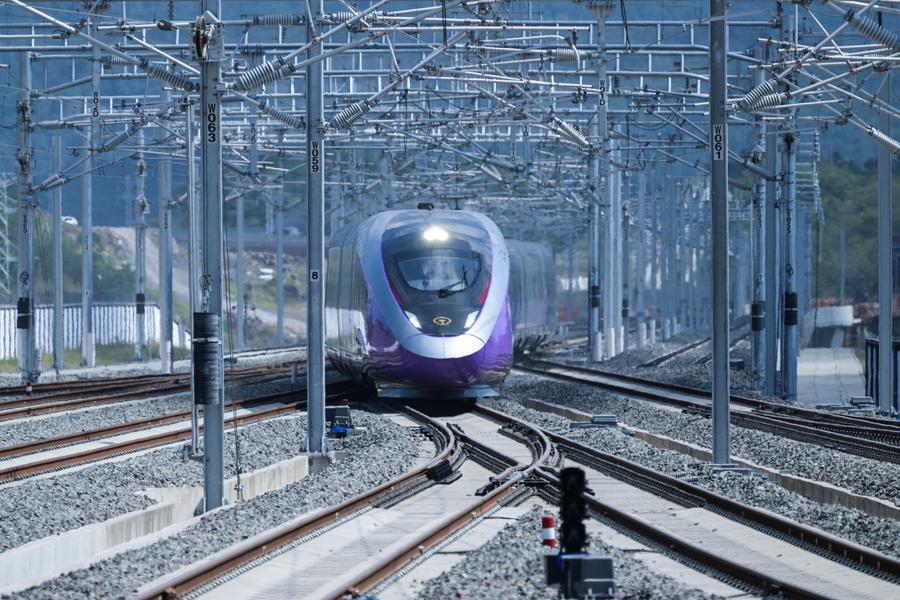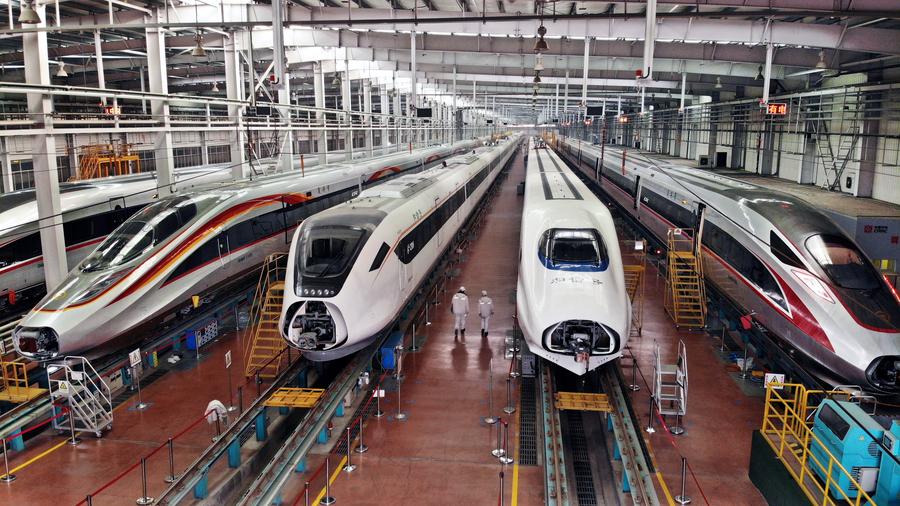
BEIJING, Oct. 9 (Xinhua) -- During the week-long National Day holiday ending on Monday迪士尼彩乐园3登录, China's high-speed railway stations were often bustling with crowds. Some passengers could be seen lined up in an orderly fashion as they prepared to board, while others could be spotted browsing their smartphones or using laptops when waiting for their boarding calls.
The country's railway sector experienced a surge in passenger traffic on Monday as travelers returned home from their holiday destinations.
A total of 13,103 trains were in operation on Monday, including 1,705 additional trains scheduled to meet the significant demand. This marked a historic high for a single day's operational capacity, according to China State Railway Group Co., Ltd.
乌克兰武装部队总参谋部 Telegram 频道上1月2日消息:袭击是在今天进行的。乌克兰武装部队对库尔斯克地区马里诺村的俄军指挥所进行了高精度打击。已采取一切必要措施,以尽量减少对当地平民生命的威胁,香港迪士尼乐园时时彩“声明说。

China has built the world's largest high-speed railway network to address the people's growing demand for convenient and comfortable travel.
The total operational length of China's high-speed railway network has exceeded 45,000 kilometers, with Fuxing high-speed trains operating across 31 provincial-level regions nationwide.
This growing volume of railway transportation is supported by innovations and high-quality development concerning China's rail transit equipment. Notably, the Fuxing high-speed train project received the State Scientific and Technological Progress Award in June 2024.

CHINESE RAILWAY INNOVATION
Once upon a time, the slow train with its signature green color dominated the travel memories of many Chinese people.
Since the Beijing-Tianjin Intercity Railway, with a design speed of 350 km per hour, entered operation in 2008, a fast-expanding modern high-speed railway network has been operating efficiently in the world's second-largest economy.
Now it takes just over eight hours to travel from Hong Kong in south China to Beijing in the north by high-speed rail, a Canadian passenger with the Xiaohongshu username Lao Han, shared on his social media platform this April, while adding that he enjoyed the different views from south to north during the journey.
Previously, a train connecting the two cities took more than 24 hours to complete a one-way trip.
Such a rail experience is not confined to the Hong Kong-Beijing trip, with many bullet trains running across the country, reaching a maximum speed of 350 kilometers per hour. CRRC Changchun Railway Vehicles Co., Ltd in Changchun, northeast China's Jilin Province, one of China's major rail transit equipment enterprises, has long been contributing to the speeding up of the country's railway travel options.
Since the 1990s, China's railway running speed has been repeatedly and significantly increased, with CRRC Changchun Railway Vehicles introducing a number of upgraded and innovative products to provide equipment support for these accelerations.
Notably, this company produced China's first subway train and first group of high-speed trains. The country's first aluminum alloy subway train, stainless steel subway train, monorail train, low-floor light rail vehicle, linear electric locomotive and automatic subway train were also manufactured in the factories of CRRC Changchun Railway Vehicles.
In July 2024, the company introduced a high-speed built-in bogie that can meet the needs of Electric Multiple Unit (EMU) trains at a speed of 400 km per hour.
The high-speed built-in bogie serves as the running system and one of the core components of rail vehicles. "It acts as the legs of an EMU train," explained Zhou Dianmai, a senior engineer of CRRC Changchun Railway Vehicles. Equipped with such a bogie, a train can run faster and more steadily, while also generating less noise.
Compared with traditional external bogies, the built-in bogie reduces the weight of the train by 20 percent -- which can cut energy consumption by 15 percent during the vehicle's operation, lower wheel-rail wear by about 30 percent, and reduce wheel-rail noise by around two decibels. In addition, maintenance cost during the whole life cycle is slashed by approximately 15 percent. This product is expected to facilitate the green and energy-saving transformation of EMU trains.
At the EMU bogie production line of CRRC Changchun Railway Vehicles, a big data analysis platform features key information, such as management costs and resource consumption. Through the processing of real-time data, this platform can generate product design and management suggestions.
"The big data analysis platform improved the equipment utilization rate by 10 percent and decreased operation and management costs by 10 percent," said Zhu Yan, deputy chief designer of the Fuxing bullet train at CRRC Changchun Railway Vehicles. Total average annual costs were reduced by more than 5 million yuan (about 700,830 U.S. dollars).
Through learning from overseas advanced experience and customizing according to China's unique conditions, the company has achieved both key technologies concerning rail transit equipment and capability in terms of R&D and manufacturing of full-range EMU trains.
On March 21, 2024, the world's first city train powered by hydrogen, independently developed by CRRC Changchun Railway Vehicles, conducted its maiden speed test run. Previously, such a combination of hydrogen energy and rail transit equipment had not been achieved.
Running at a speed of 160 kilometers per hour at full load, the train consumed only five KWh energy per kilometer, while the data measuring each system confirmed stability during the test.
So far, CRRC Changchun Railway Vehicles has managed to build nine product platforms with advanced EMU, subway trains and maglev trains, covering R&D capabilities in terms of full-type and full-variety rail transit products.

WELCOME ABOARD CHINESE TRAINS
China's high-speed trains, a successful example of independent innovation, are now regarded as a Chinese "calling card" and are welcomed globally.
Indonesia's Jakarta-Bandung high-speed railway (HSR) noted in July 2024 that it had carried 4 million passengers since it began commercial operations on Oct. 17, 2023. Indonesian drivers have successfully operated the trains serving the HSR at a speed of 350 kilometers per hour.
This is the first overseas high-speed railway project fully utilizing Chinese railway systems, technology and industrial components.
The China Academy of Railway Sciences (CARS) has undertaken supervision and consultation concerning this high-speed railway, and has provided support in fields such as on-site quality control, drawing reviews and technical research.
The 142.3-km high-speed railway has shortened the journey between Indonesia's capital, Jakarta, and Bandung, a famous tourist city, to only 40 minutes.
Meanwhile, a landmark project of high-quality Belt and Road cooperation, namely the China-Laos Railway, began operations in December 2021.
"Before the China-Laos Railway opened, it took me two days to travel from Vientiane to Mongla by car," said a Lao passenger. "Now, it takes me about five hours by train, which is very fast and convenient."
Another Chinese-built project, the Belgrade-Novi Sad high-speed railway, has transported nearly 8.8 million people between Serbia's two largest cities since starting operation in 2022.
At the Third Belt and Road Forum for International Cooperation in October 2023, CRRC Changchun Railway Vehicles signed a purchase contract with Serbia to introduce China's bullet trains to this country in Eastern Europe.
Based on a mature and reliable technical platform, both design and production of trains are tailored according to local railway conditions and technical specifications.
In recent years, the products of CRRC Changchun Railway Vehicles have been exported to 23 countries and regions. The company's export business model currently covers the full life cycle service of vehicles, and it has set up 11 branches and subsidiaries worldwide.
"China's high-speed trains feature high levels of science and technology, strong brand influence and thriving innovation," said Tao Guidong迪士尼彩乐园3登录, a scientist of CRRC. ■

